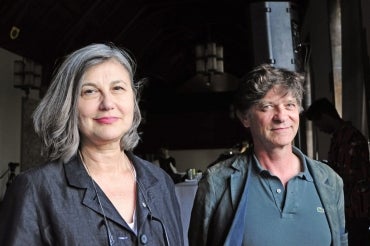Building museums, building cities: U of T hosts all-star panel of artists and architects

Published: June 28, 2016
Imagine Toronto without the Royal Ontario Museum or the Art Gallery of Ontario.
The ROM’s Lee-Chin Crystal and Frank Gehry’s long glass and wood façade at the AGO have reached iconic status in the city – and Toronto would feel emptier without them. The buildings themselves have become as important as the artifacts they house.
The relationship between cities and their cultural institutions was the topic of “Building Museums: Building Cities” – a discussion, organized by the Art Museum at the University of Toronto and the French Consulate General in Toronto, which took place on June 24 at Hart House.
Moderated by Richard M. Sommer, dean of the John H. Daniels Faculty of Architecture, Landscape, and Design at the University of Toronto, the talk centred on the cultural role of museums and the importance of making these spaces accessible to a broader audience.
Speakers included artist Adrian Blackwell, architect Éric Lapierre and journalist Philippe Tretiack – both from France, architect Charles Renfro who is a partner at design studio Diller Scofidio + Renfro and alumna Shirley Blumberg, founding partner of KPMB Architects.
A diverse group of people from students and alumni to architects and art curators packed into the Debate Room at Hart House to listen to and participate in the discussion.
For attendee Cynthia Roberts, who holds a Masters of Museum Studies from U of T, the event highlighted the importance of talking about art and architecture so that decision makers are aware of its importance and the need for funding.
“It’s a never-ending task to engage people in arts, culture and preserving heritage,” says Roberts, who is currently a content manager at an international design firm.
Sociology graduate student Noga Keidar and Architecture and geography grad Jessie Ouyang were part of a group of University of Toronto students who recently traveled to Israel to learn about urban growth and regeneration. Inspired by what they learned, they decided to come to the event to hear the panellists’ perspectives.
More about their trip
“I’m interested in the role of museums in the urban economy and the connection between art and industry,” says Keidar.
Toronto is an interesting backdrop for a talk about the relationship between city and culture. While its creative scene is growing, Sommer told U of T News that Toronto’s cultural institutions are struggling to keep up.
“They don’t have the scale or the extent or the resources that are in sync with the growth and the exuberance of the city itself,” he says.
Panelists weigh in
“It’s very much trying to establish a new relationship between the artist, the institution, the audience and the wider community,” said Blumberg on what goes into designing a museum.
She spoke about her involvement in the creation of the Remai Modern Art Gallery of Saskatchewan in Saskatoon – a project she says was designed to respect both the landscape that surrounds the museum and the city’s indigenous community.
Architects must also foster relationships with art curators to ensure that the interior gallery space does the art justice.
“Museums have both an opportunity and obligation to provide new experiences for the public but we’re also really conscious of and concerned about the art everyone is seeing inside,” says Charles
Renfro, whose firm has designed major cultural buildings around the world from Rio de Janeiro to Berkeley California.
Diller Scofidio + Renfro is currently collaborating with Architects Alliance to design the new University of Toronto Centre for Civilizations and Cultures where the McLaughlin Planetarium currently stands.
“Building Museums: Building Cities” was not without some friendly debate, but the panel had nothing but praise for one of Toronto’s most unique cultural spaces – the Hearn Generating Station – the decommissioned plant that has hosted a number of events. It most recently housed performances and installations for the Luminato Festival.
“I was blown away by what it is,” said Renfro.
The relationship between technology and art was also a hot-button issue – with agreement across the panel that while anything and everything can be found online, there’s still something special that still draws people to museums and galleries.



